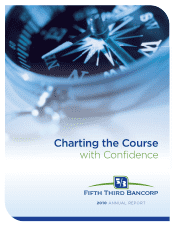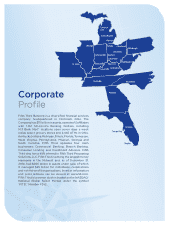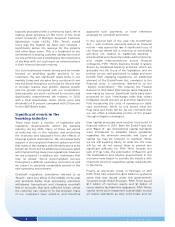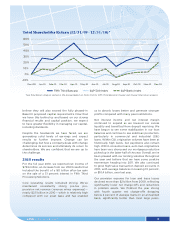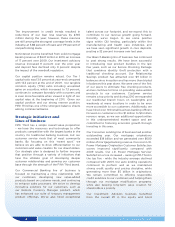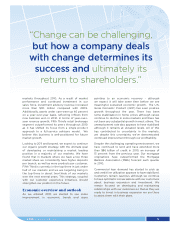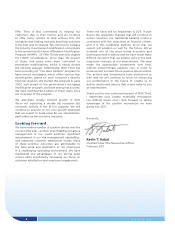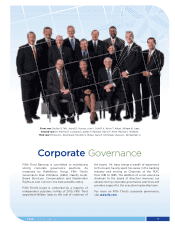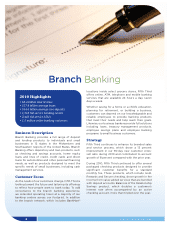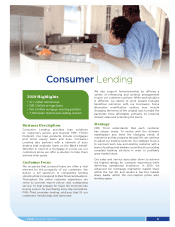Fifth Third Bank 2010 Annual Report Download - page 4
Download and view the complete annual report
Please find page 4 of the 2010 Fifth Third Bank annual report below. You can navigate through the pages in the report by either clicking on the pages listed below, or by using the keyword search tool below to find specific information within the annual report.
FIFTH THIRD BANCORP2
typically associated with a community bank. We’re
making great progress on this front. In the most
recent University of Michigan American Customer
Satisfaction Index (ACSI), Fifth Third’s overall
score was the highest we have ever received –
significantly above the average for the industry
and other large peers. This is a testament to our
commitment in making customer satisfaction one of
our top priorities and it emphasizes the importance
of working with our customers as valued partners
in their financial decision making.
Our core businesses remain strong and we remain
focused on providing quality products to our
customers. We see significant opportunity in our
markets today and our sales force continues to win
new business throughout our footprint. We see that
in stronger relative loan growth, deposit growth
and fee growth compared with our competitors.
Subsequently, our stock continued its recovery and
significantly outperformed the industry in 2010,
with a total shareholder return (stock price plus
dividends) of 51 percent compared with 20 percent
for the S&P Banks Index.
Significant events in the
banking industry
There have been a number of legislative and
regulatory developments within the banking
industry during 2010. Many of these are aimed
at reducing risk in the industry and protecting
the economy and taxpayers from the eects of
financial system dislocations. We wholeheartedly
support a strong global financial system and feel
that many of the changes will ultimately prove to be
beneficial. There will be additional costs associated
with implementing many new regulations; however,
we are prepared to address any challenges that
may lie ahead. We’ve demonstrated success
throughout a dicult operating environment and
we expect to generate sustainable growth in the
new operating environment.
Overdraft regulation, sometimes referred to as
“Reg E,” went into eect in the middle of the year
and prohibits banks from processing electronic
withdrawal transactions and charging overdraft
fees in accounts that lack sucient funds, unless
the customer has “opted-in” to the program. Many
of our customers have opted-in, and therefore
approved such payments, or have otherwise
arranged for overdraft protection.
In the second half of the year, the Dodd-Frank
Act – with multiple elements aimed at financial
reform – was signed into law. A significant focus of
the financial reform bill is reducing or eliminating
activities not related to traditional banking –
activities that are inherently volatile, add complexity,
and create interconnections across financial
companies. Fifth Third’s business model is largely
driven by traditional banking activities, which are
generally not the focus of the legislation, and we
believe we are well-positioned to adapt and even
benefit from changing regulations. An
additional
element of the Dodd-Frank Act, unrelated
to the
financial crisis, is commonly referred to as the
“Durbin Amendment.” This requires the Federal
Reserve to limit debit interchange rates charged to
merchants by issuers. Significant limits have been
proposed on such interchange rates that unless
mitigated, would prevent us and other banks from
fully recapturing the costs of operating our debit
card businesses. While no one knows what the
final rules and limits will be, we are confident that
we can oset a substantial portion of the impact
through mitigation strategies.
New capital proposals were another focal point of
financial reform in 2010. Both the Dodd-Frank Act
and “Basel III” (an international capital standard)
were introduced to establish future guidelines
regarding the minimum amounts and types of
capital we may be required to maintain. While
we are still awaiting clarity on what the U.S. rules
will be, we do not expect them to present any
significant diculty for Fifth Third. Despite the
lack of final rules, the publication of Basel III and
the stabilization and relative improvement in the
economy have begun to provide the industry with
important direction regarding capital requirements
in the future.
Finally, as previously noted, in February of 2011
Fifth Third fully repaid the $3.4 billion in preferred
stock that was issued under the government’s
Troubled Asset Relief Program. Fifth Third issued
$1.7 billion of common equity and $1 billion of
senior debt to facilitate this repayment. Fifth Third’s
capital levels upon repayment substantially exceed
all capital standards as they exist today and we

